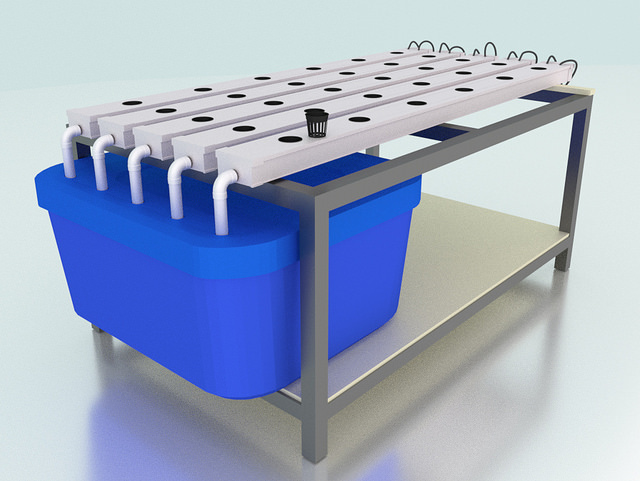Nutrient Film Technique, continued
This is page 7 of our twelve page series on nutrient film technique. Click any of the below pages to jump to that page.
Page 1 Page 2 Page 3 Page 4 Page 5 Page 6 Page 7 Page 8 Page 9 Page 10 Page 11 Page 12

A sample, small-scale commercial system. These systems are commonly available from multiple online and brick-and-mortar retail outlets. These systems will definitely cost more up front, but they may save considerable time and effort over a DIY system.
Estimated Costs for Nutrient Film Technique Systems
While it would be nice to give exact costs for various nutrient film technique configurations, the sheer number of options makes that impossible. Having said that, I can say that NFT systems are generally extremely cost effective. That's with one caveat: when the crop is well-paired with the NFT channel’s pro’s and con’s as described in previous sections. Hydroponic salad greens and strawberries have such high market value, and are so prone to disease and damage in soil-based field production, that they are at the top of the list for cost effective NFT crops. I’m being careful here to not promise they’d be profitable, because that depends on a lot of variables which have nothing to do with whichever hydroponic approach is selected. That being said, leafy greens and strawberries are excellent choices if you want to use the nutrient film technique system but aren’t yet sure what to grow in it.
To take a broader look, there are two sets of costs for any hydroponic system, namely, the cost of acquisition and then the cost of operation. Let's take the cost of acquisition first. That topic in turn generally boils down to two options: purchase a system or build your own. We’ll talk in more depth about the pro's and con's of each approach in the DIY section below. For the context of cost effectiveness, suffice to say that very small nutrient film technique systems can certainly be an easy and inexpensive DIY project for those who are so inclined. Net pots and suitable growing media are readily available both from online retailers and local brick-and-mortar stores. The NFT channels can be made from standard raingutters which are available from any reasonable-sized hardware store or home improvement center. I should note that if you’re buying NFT channels from those sources, you’ll want the vinyl channels rather than the metal channels. Metal channels run the risk of introducing unwanted heavy metal contaminants into your nutrient solution over time. The required plumbing materials, including the reservoir, can also easily be sourced at a hardware store or home improvement center. Once the materials are sourced, a small NFT system could be put together in a weekend.
For larger-scale growers, there comes a point where buying a ready-built turnkey system would be more cost effective than making a system from scratch. In those systems, the spacing between plants, the slope of the channel, the irrigation cycle and other variables have already been worked out. Trying to build a large DIY system rather than buying a turnkey system would therefore be roughly equivalent to reinventing the wheel.
For those growers who are in between, a useful exercise would be to first search for turnkey kits or assemblies of ready-made NFT systems, then start pricing out what it would cost you to buy all the same components from scratch. THEN, calculate how many hours you’ll spend putting together the ready-made system versus the DIY system. For those of us who need to make every dollar count, AND every hour count, that comparison will usually provide a clear winner one way or the other.
The second general topic of cost, namely operational expenses, also depends on too many variables to list here. However, we can again give some general statements. The smaller the system, the less differences will be observed in operational costs between DIY and purchased systems. As the scale goes up, the DIY systems will start to cost more and more relative to purchased systems of the same size. This is because DIY systems generally do not have quite as much efficiency built into them as purchased systems.
Back Next
Click any of the below links to jump to that page.
Page 1 Page 2 Page 3 Page 4 Page 5 Page 6 Page 7 Page 8 Page 9 Page 10 Page 11 Page 12